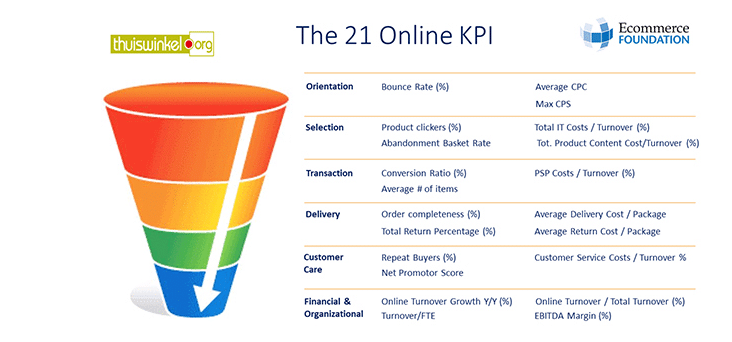KPIs for ecommerce should be used to measure your business’ milestones, achievements, and specific objectives for a specified period. It’s also important to remember that any goal you set must be SMART: Specific, Measurable, Achievable, Realistic, and Timely. These are the five pillars of KPIs that will help you actualize your vision.
If you want to run a successful ecommerce website, it’s important to set clear goals and put measures in place to review and achieve those goals.
What Are KPIs In The Context Of Ecommerce?
KPIs (Key Performance Indicators) for ecommerce are measurable criteria that assess and achieve progress. They emphasize the SMART principle of goal-setting by focusing your efforts on important areas. For example, a KPI is typically a specific, attainable goal that has a deadline and corresponding course of action.
Put simply, key performance indicators are used to determine whether a goal or a set of goals is being accomplished and to what extent. For instance, one of the common KPIs for ecommerce success is the number of visitors your site attracts each day. This helps you determine how successful your business is at attracting and retaining traffic. By keeping SMART principles in mind, as well as your site analytics, you can set your KPI of daily site visitors to a realistic target and then use this to track progress.
Why Are KPIs Important For Ecommerce?
One great advantage of ecommerce is its digital trails, which are relatively easy to analyze (although there are times when the sheer amount of data you can access is mind-boggling! It’s all about knowing what to look at). This isn’t as easy for offline businesses. If you have a restaurant, for example, it can be a challenge to work out which of your new customers responded to which advertising method, whether that’s ads in the local newspaper or on social media, flyers through the door, or even through word-of-mouth.
Unlike a brick-and-mortar store, however, data that analyzes and tracks site traffic, bounce rate, and transactions is readily available to ecommerce businesses, and can be automatically collated into manageable, easy to digest reports. In most cases, this is also super easy to do because website algorithms and apps automatically track the data and provide analytics for you. This means that you’ll be able to tell which customers came from where, what their experience was like, and what you can do better going forwards.
Setting KPIs for ecommerce allows businesses to track site performance and customer behavior over a specific period of time. During this time, patterns can emerge within 24 hours, making your business more streamlined by giving you important insights early on. When it comes to product inventory, for example, having a KPI in place will allow you to see which products in your online store are selling the fastest. This gives you ample time to restock the relevant products while also letting you know what interests your audience most.
With all this in mind, ecommerce KPIs are the benchmarks that determine whether certain operations, strategies or processes are working as expected. Since most ecommerce data is updated in real time, it also means that your business will be able to react more fluidly to ever-changing market dynamics.
How To Know Which Are The Best KPIs for Ecommerce for Your Brand
There are many ecomm metrics that can be measured by Google Analytics, other search engines, and through a variety of different tools, but not all of these will be relevant to your ecommerce brand. It’s important to identify which metrics matter most to your business goals so that you use the right KPIs. One of the most common KPIs for ecommerce businesses is conversion rate, which measures the proportion of total sales against the number of site visitors.
Similarly, ‘dwell time’ is a key performance indicator for ecommerce websites and ad campaigns because it tells you how long a lead spent on your page. You can then use this information to refine your content and marketing strategies so that you engage more people and, fingers crossed, convert them to customers.
Choosing KPIs that are best-suited to your ecommerce business is crucial if you want to see measurable progress and achieve realistic goals. Here are some factors to consider:
- Business goals: Generally speaking, the main goal of any business is, of course, to earn profit. However, the means of achieving this depends on your product or service, and on your target market. KPIs on how to gauge profitability vary from one business to another. For example, the profitability KPIs for small-ticket consumer products, like cosmetics, are measured per unit sold, instead of per customer.
- Business scalability: All businesses are scalable, but only up to a certain point. Many factors limit the expansion of a business. For example, start-up businesses have high rates of failure, mainly because of fierce competition and their comparative lack of capital. If you want your business to grow and improve, you’ll need to track KPIs that stimulate growth. Known as growth levers, these can include monthly returning revenue (MRR) and project deliverability, i.e. how fast your turnaround is for customers.
- Competition: Business competition is inevitable, even if you’re the first one who conceptualized a business model or product and you have first mover advantage; eventually, others will develop the same business model or product. Competition can be fiercer if you’re a late-comer in the industry. In these cases, you might consider KPIs that are based on the metrics of your competitors, so that you better understand how you can outperform them and what you can offer customers that they can’t.
- Cost-effectiveness: This applies to any business-related expenses that you make, from advertising campaigns to SEO strategies. ROI (return of investment) is a common KPI used to monitor how cost-effective your business is, allowing you to see how much you’re spending compared to how much you’re earning.
- Target customers: The demographic profile of your target customers can also be used as the basis for choosing actionable KPIs for ecommerce. When you collect data on the age, gender, location, and online habits of your leads, you’ll be able to tailor your ecommerce business to suit their needs and interests.
15 Popular KPIs For Ecommerce And Why You Need Them
Ecommerce businesses can use various types of KPIs, depending on certain metrics. Metrics can be combined to determine specific KPIs that are aligned with the goals of your business. There could be hundreds of KPIs depending on the business goals and metrics that you want to measure – but often, less is more. You don’t want to get stuck in analysis paralysis, which is easy to do!
To avoid this, try keeping your KPIs fairly simple, and only choose the ones that are critical. As you start to measure your ecomm data, you might find some of your KPIs aren’t as useful as you thought they would be, or conversely that there are other things you should be measuring. Don’t be afraid to tweak your ecommerce KPIs until they really work hard for you.
In general, ecomm KPIs can be classified into four categories, which correspond to the various stages of the customer journey and marketing funnel. Here are some examples per category:
Awareness KPIs: How customers found your ecommerce site
1. Sources of traffic and platforms: This indicates where your visitors originated from, as well as the device they’re using. This metric can also identify geographical locations of users and the websites that referred them to your website, such as search engines, blogs or social media.
2. Impressions by channel: In the awareness phase, it’s important to understand which channel visitors are using to access your site so you can better figure out where your opportunities lie and how you can scale. You can look at organic traffic sessions, and measure how many visitors click through to your website as a result of unpaid search results.
You can also look at PPC (pay-per-click) or ad impressions, basically just any traffic that’s generated from activity like Google Ads, social media campaigns, or other forms of paid advertising. This will give you better insights on which mode of advertising your audience responds most to and tell you which platform or avenue is most successful at naturally attracting leads.
3. Click through rates: The click through rate, or CTR, measures the number of people who click on the links you want them to click on. You can use this metric to better understand which key terms or messaging resonate, so you can identify your audience.
Consideration KPIs: How your target customer understands the need for your product
4. Bounce rate: This measures the number of visitors who leave your website and how long it took for them to do it. This is an important metric for optimizing site performance, content, and user experience.
5. Duration of session: You can also track the amount of time visitors spend on your website. A longer duration indicates that visitors are interested and actually reading the content.
6. Email list growth: Email subscriptions require some level of consent and interest. If your subscriber list is growing, it tells you that people are sufficiently interested in your emails and products.
7. Social media followers: You can also track social media growth as a way of tapping in to your audiences’ interests and seeing who is most receptive to your content.
8. Site traffic: The number of visitors to your website, or your site traffic, is a leading indicator of conversions, and ties to impressions through a CTR.
Conversion KPIs: How and to what extent you convert your leads into paying customers
9. Cost of customer acquisition: This monitors the amount of money spent on advertising in proportion to the numbers of customers converted. For example, if you spent $100 on ads and you were able to attract 200 customers or paid subscribers, then the cost of acquisition is $2 per customer.
10. Online transactions: The total volume of transactions can be tracked on a daily, weekly, or monthly basis as an objective way of measuring your site’s performance, growth, and conversion rate.
11. Average order value : This metric compares the prices of the items customers buy, and averages them out so that you have an idea of how much a typical customer is spending on one order.
12. Abandonment rate of carts: Many customers won’t buy immediately, especially if it’s a big ticket item. Instead, they’ll temporarily save the product in their cart and leave the site. High cart abandonment rates means lower conversion rates, so this is an important metric to keep an eye on.
13. Ecommerce conversion rate: This will tell you the percentage of users who made a transaction on your site.
Retention KPIs: Measure the level of customer loyalty and repeat transactions
14. Lifetime average value of each customer: This is the average amount of revenue and profit generated from each customer for as long as they purchase from you.
15. Number of repeat transactions per customer: This is related to the lifetime average value of each customer. A customer that has higher repeat transactions typically also has a higher lifetime average value compared to those who have spent the same amount of time on the site, but purchased less.
How To Measure KPIs for Ecommerce
The good news is that in many cases, measuring KPIs can be automated. There’s a lot of online software out there (Google Analytics being the prime example) that can take raw data and convert it into regular reports.
Once you know which ecommerce KPIs are most important for you to measure, you can then analyze the data you get on a regular basis. We recommend doing this no less than monthly, so you have a solid overall picture of how your site is performing, and you can quickly put improvement measures in place where necessary.
Once you have your KPIs in place and are measuring them, you’ll be better able to predict future trends, forecast ad budgets and plan successful campaigns – and, ultimately, increase revenue.





